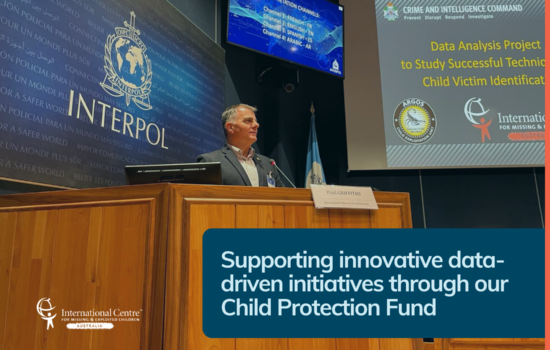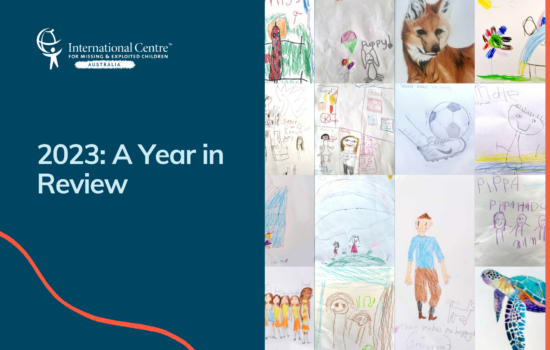The new “Stranger Danger”: Tactics used in the online grooming of children

Eva Veldhuizen-Ochodničanová, MSc | ICMEC Partner
Most of us have been made aware of the dangers posed to children by strangers in low-brimmed hats and trench coats offering free lollipops. Many of us even grew up with a caretaker telling us “don’t talk to strangers” as they tried to protect us from the worst kinds of abuse.
But children today face a new kind of danger, one not as easily identifiable as a man in a trench coat. This newest threat to children’s safety is almost invisible, thanks to the age of the Internet.
The Internet provides offenders a few advantages: an affordable means to increase accessibility to youth, while simultaneously ensuring perceived anonymity, shielding them from the eyes of law enforcement.
By facilitating access to children, the Internet offers offenders new ways in which to sexually exploit children. This includes but is not limited to:
a) production, possession, and distribution of child sexual abuse material (CSAM);
b) live streaming of child sexual abuse;
c) sexual extortion;
d) harassment of children;
e) sharing of self-generated sexual content involving children; and
f) unwanted exposure of a child to sexual content.
Online child sexual exploitation — as with in-person exploitation — rarely occurs without preceding and coinciding behaviors designed to encourage a child to engage in sexually explicit conversations, share explicit photographs and videos, or meet up with an offender in person, as well as ensuring children do not reveal abuse is taking place.
These collective behaviors are what is termed ‘online sexual grooming.’
Although each individual case of online sexual grooming is unique, forensic psychologists, investigators, and law enforcement officers have been able to identify similarities in the patterns that offenders engage in to perpetrate child sexual exploitation online.
Most online grooming models have these five stages in common.* Understanding these stages can help you recognize and intervene in the grooming process and keep the children in your life safe from exploitation.
*These five stages originate from Winters and Jeglic’s Sexual Grooming Model, which was adapted for an online context utilizing preexisting models of online sexual grooming.
Stage 1: Victim Selection

*Real interactions between online sexual grooming offenders and a decoy.
In the early stages of the online grooming process, online groomers will undertake a risk assessment, in which they appraise the personal characteristics of the child as well as the online and offline environments surrounding the child. Children who are particularly vulnerable to online grooming often share similar characteristics and personal situations including low self-esteem, difficult family circumstances, and a lack of supervision on the Internet.
Stage 2: Access & Isolation

Once a suitable target has been identified and the offender has gained access to the child, grooming can begin. The offender will engage the child in conversation, and attempt to establish a sense of privacy, for instance asking where the child accesses the Internet, or what their parents’ schedules are.
Isolation then begins. Groomers embrace the sentiment that their relationship with the child is special, using manipulation to become the center of the child’s world. They encourage the victim to hide their relationship from their families.
Stage 3: Trust Development

In the trust development stage, offenders aim to develop a trusting friendship or relationship with their victim. This can involve several tactics, including:
a) praising the child for their maturity and intelligence;
b) encouraging the child to disclose personal information;
c) syncing their language with that of the child;
d) highlighting mutuality (i.e., similar interests, attitudes and behaviors between the offender and child); and finally,
e) portraying themselves as being trustworthy and nice.
Stage 4: Desensitization

Having developed a trusting bond with the child, offenders introduce sexual content into the conversation, increasing in intensity over time. The exact nature of this content differs, but can include both implicit and explicit sexual conversations, the introduction of sexual content as a game, or the offering of sexual advice. Escalation may include the sending and receiving of nude images or videos, livestreaming sexual content, as well as arranging for in-person sexual encounters.
Stage 5: Post-Abuse Maintenance

The goal of the final stage is to ensure the child remains trapped in the cycle of abuse, by either reinforcing and maintaining trust in order to prevent disclosure, or by explicitly threatening or blackmailing the child or their loved ones. Trust can be reinforced and maintained by, for instance, giving the child affection, praise or encouragement for one’s actions.
Online sexual grooming is not a rare occurrence. Some studies report almost 10{c2f11fc84a3485dadd82310c0182835fa7f8467b77f5d487b58281dc4d7d2824} of children having experienced unwanted sexual enticement online in the past year.
The COVID-19 pandemic led to a significant rise in online grooming due to the increased time children were spending online with little supervision. Over the last two years, children have had increased exposure to social media platforms, gaming communities, messaging apps, and live webcam chat rooms which are locations in which online grooming has been shown to take place.
The U.S.’s National Center for Missing and Exploited Children (NCMEC) recorded a 97.5{c2f11fc84a3485dadd82310c0182835fa7f8467b77f5d487b58281dc4d7d2824} increase in reports from the public concerning online sexual enticement between 2019 to 2020.
According to the 1st edition of ICMEC’s Online Grooming of Children for Sexual Purposes: Model Legislation & Global Review published in 2017, only 63 of the 196 countries reviewed had dedicated legislation addressing online grooming.
Preliminary results of the 2nd edition of this report show that at least 14 more countries have added legislation addressing online grooming.
While we may be able to identify the mechanisms offenders use in online sexual grooming, there is still much to be done to increase awareness of the extent/scope of the issue and the impact and harm to children it presents.
That is why ICMEC is committed to spreading awareness, providing education, building capacity, and encouraging positive policy change to help address online grooming and other emerging forms of online child sexual exploitation and abuse.
We work with educators, parents, the public and private sectors, and child defenders like you to tackle these issues and protect children all around the world.
To learn more about online grooming, please refer to our Online Grooming of Children for Sexual Purposes: Model Legislation & Global Review 1st edition (the 2nd edition to be published soon) and visit our Education Portal for more resources on preventing, recognizing, and responding to online grooming of children.
Eva Veldhuizen Ochodničanová is a multi-national Forensic Psychologist specializing in sex trafficking and child sexual abuse crimes. Currently, her main roles orient around training global law enforcement agencies, carrying out investigations into perpetrators of sex trafficking and CSA crimes and conducting academic research into the modus operandi of perpetrators of sexual crimes. She has previously worked at the International Criminal Court in the Hague, the Sexual Behavior Service at SWLSTG in London and the Sex Offender Research Lab at John Jay College of Criminal Justice in NYC.
The International Centre for Missing & Exploited Children (ICMEC) is a non-governmental organization working to make the world a safer place for all children by defending against child sexual exploitation, abuse, and the risk of going missing. ICMEC coordinates with partners around the world to develop research, technologies, and educational resources to aid in the search and recovery of children who are missing, fight child sexual exploitation, and empower caring professionals, institutions, and communities to safeguard children from all forms of sexual abuse.
For more information go to www.icmec.org.
References:
Briggs, P., Simon, W. T., & Simonsen, S. (2011). An exploratory study of Internet-initiated sexual offenses and the chat room sex offender: Has the Internet enabled a new typology of sex offender? Sexual Abuse: A Journal of Research and Treatment, 23(1), 72–91.
EUROPOL. (2017). Online sexual coercion and extortion as a form of crime affecting children: Law enforcement perspective. The Hague: European Union Agency for Law Enforcement Cooperation.
Internet Watch Foundation. (2018a). 2017 Annual Report. Retrieved from www.iwf.org.uk
Mitchell, K. J., Jones, L. M., Finkelhor, D., & Wolak, J. (2011). Internet-facilitated commercial sexual exploitation of children: Findings from a nationally representative sample of law enforcement agencies in the United States. Sexual Abuse: A Journal of Research and Treatment, 23(1), 43–71.
Mitchell, K. J., Jones, L. M., Finkelhor, D., & Wolak, J. (2014). Trends in unwanted sexual solicitations: Findings from the youth internet safety studies. Durhman: Crimes Against Children Research Center
National Center for Missing & Exploited Children. (2017). The online enticement of children: An in- depth analysis of CyberTipline reports. NCMEC.
National Center for Missing & Exploited Children. (2018c). Online Enticement. Retrieved from www.missingkids.org
National Center for Missing & Exploited Children. (2021). CyberTipline 2020: Rise in Online Enticement and Other Trends From Exploitation Stats, NCMEC. Retrieved from: https://www.missingkids.org/blog/2021/rise-in-online-enticement-and-other-trends–ncmec-releases-2020-
Seigfried-Spellar, K. C., & Soldino, V. (2020). Child sexual exploitation: Introduction to a global problem. The Palgrave handbook of international cybercrime and cyberdeviance, 1203–1223.
Weprotect Global Alliance. (2021). Global Threat Assessment 2021.
Available at: https://www.weprotect.org/global-threat-assessment-21/#report
Williams, Rebecca; Elliott, Ian A.; Beech, Anthony R. (2013). Identifying Sexual Grooming Themes Used by Internet Sex Offenders. Deviant Behavior, 34(2), 135–152.
Winters, Georgia M.; Jeglic, Elizabeth L.; Kaylor, Leah E. (2020). Validation of the Sexual Grooming
Model of Child Sexual Abusers. Journal of Child Sexual Abuse, 1–21.
Winters, G. M., Kaylor, L. E., & Jeglic, E. L. (2017). Sexual offenders contacting children online: an examination of transcripts of sexual grooming. Journal of sexual aggression, 23(1), 62–76.
Winters, G. M., Schaaf, S., Grydehøj, R. F., Allan, C., Lin, A., & Jeglic, E. L. (2022). The Sexual Grooming Model of Child Sex Trafficking. Victims & Offenders, 17(1), 60–77.



